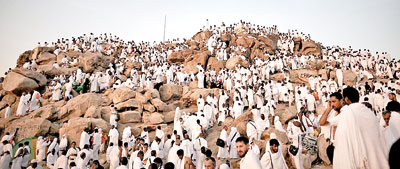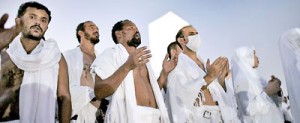Sunday Times 2
Tears flow and prayers fill the air over Mount Arafat
Tears flowed and prayers filled the air as the annual Muslim hajj by about 2 million believers from around the world reached its zenith on a vast plain in western Saudi Arabia today.
Hundreds of thousands of pilgrims arrived at Arafat carrying suitcases and other luggage among thousands of white tents which stood ready to provide temporary homes for the multitude of pilgrims as they began the five-day ritual central to Islam.

Emotional: Tears flowed and prayers filled the air as the annual Muslim Hajj by about 2 million believers from around the world reached its zenith on a vast plain in western Saudi Arabia (AFP)
Many set up their own tents along the roads. Others even made rough shelters from large yellow garbage bags.
Elderly pilgrims sat in wheelchairs, little ones in prams, and others leaned on sticks as they pushed their way towards Mount Mercy, the hill where Muslim Prophet Mohammed made his final sermon 14 centuries ago.
‘I am now a newborn baby and I don’t have any sin,’ Nigerian pilgrim Taofik Odunewu told AFP, standing at the foot of Mount Mercy on the Arafat plain, tears streaming down his face. Odunewu raised his hands to the heavens in the seamless two-piece white ‘ihram’ outfit that he wore.
From early morning, pilgrims crowded onto the slippery, rocky hill, which their uniform attire turned white in colour.
Some prayed and wept, some slept, while others spread their mats and sat reciting the Koran.
All male pilgrims dress in ihram to symbolise a state of purity, which also emphasises their unity regardless of social status or nationality.
‘I pray for prosperity, long life and.. I pray for my country,’ Odunewu said with a broad smile. ‘I feel great… I’m on top of the world,’ he said at the world’s largest Muslim gathering. ‘I’m very blessed to be part of this occasion. I don’t think I will go back to the sinful way,’ he pledged.

Protection: Pilgrims from Nigeria were permitted to enter Saudi Arabia for hajj, despite eight Ebola deaths in their country. Some pilgrims wore masks for protection (AFP)
The Hajj, which officially ends on Tuesday, is one of the five pillars of Islam that every capable Muslim must perform at least once. It comes after reports that the annual pilgrimage has seen a rise in the number of pictures being taken on camera phones during the rite of passage in Saudi Arabia as followers share their experiences with family and friends back home.
But some scholars have taken issue with the practice, which they see as a ‘touristy’ distraction from the prayers and rituals that form one of the five pillars of Islam.
Security forces were deployed en masse across Arafat plain and Mount Mercy to organise the flow of pilgrims, who have come from 163 countries as well as Saudi Arabia, home to Islam’s holiest sites. ‘This way Hajji. Don’t stop here. You’re blocking the way,’ security men shouted through loudspeakers, trying to control the crowds. The number of faithful seemed fewer than past years following a crackdown by authorities on illegal pilgrims. This year’s Hajj comes with Saudi Arabia and four other Arab nations joining Washington in air strikes against Islamic State group militants who have committed a spate of atrocities in Syrian and Iraqi territory they seized.
Saudi authorities are also striving to protect pilgrims from two deadly viruses, Ebola and the MERS coronavirus.
No such cases have been recorded among the Hajj visitors, officials say.
Odunewu and other pilgrims from Nigeria were permitted to enter Saudi Arabia for Hajj, despite eight Ebola deaths in their country.
Three West African states hardest hit by Ebola have not been allowed Hajj visas. Every adult Muslim is required to complete the Hajj pilgrimage at least once in their lifetime as long as they are physically and financially capable of making the expensive and difficult journey.
Each year, Muslim faithful from about 180 countries converge on the Islamic city of Mecca and other locations in western Saudi Arabia to complete the holy journey.
The week of Hajj occurs during the last month of the Islamic calendar and requires pilgrims to perform ten services or rituals before and during Hajj.
On the first day of Hajj, Muslims proceed to Mina for prayers then head to Mount Arafat, around 20km east of Mecca, the following day to repent their sins. Men are required to wear two white seamless cloths with no knots and footwear must show the ankle and back of the foot, it was noted by the International Business Times.
Women are not allowed to wear the traditional Burqa and Niqab to ensure their faces can be seen.
In the second phase, known as Tawaf, when the faithful reach the Grand Mosque, they walk counter-clockwise seven times around the cube-shaped Kaaba – believed to have been built by Abraham 4,000 years ago.
It is this building that, wherever you are in the world, Muslims are expected to face when praying – it is the most sacred location in Islam. Each circuit starts by kissing the Black Stone, called Hajar al-Aswad. Alternatively, pilgrims can point to it if prevented by the crowds.
After the circuits, pilgrims pray before drinking water from the Zamzam well, which is dispensed in coolers around the mosque.
The third rite, known as Sa’ay, requires walking or running seven times between the hills of Safa and Marwah, which are now enclosed by the Grand Mosque.
Afterwards, the men shave their heads and women cut off part of their hair to end the restriction of Ihram.
The sixth requirement sees the pilgrims arrive back at Mina to perform a symbolic stoning of the devil.
They do this by throwing seven stones at the largest of three pillars, which for safety reasons have now been replaced by walls with areas to catch the projectiles.
After this, animals are slaughtered to mark the sacrifice of Abraham and Ishmael.
In the eighth rite, the pilgrims return to the Grand Mosque for another Tawaf. Then, on the fourth day of Hajj, they head back to Mina to ‘stone the devil’ again and repeat this ritual the following day.
For the final rite, the pilgrims return to the Grand Mosque for a farewell Tawaf.
Hajj, the fifth of the pillars of Islam, coincides with the Eid al-Adha festival, known as the Feast of the Sacrifice and is meant to commemorate the trials of Prophet Abraham and his family.
© Daily Mail, London

